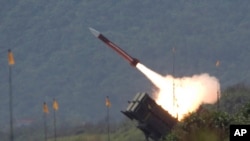Differences are emerging between Congress and the White House concerning missile defense policy, as outlined in the proposed annual defense bill known as the National Defense Authorization Act.
The $874 billion budget passed by the House on Friday calls for the military to maintain a "credible nuclear capability" to deter adversaries, while developing and deploying layered defense systems that can defeat complex missile threats "in all phases of flight."
In a statement last week, the White House criticized this section of the proposed NDAA on grounds that it would "undermine U.S. strategic deterrence" with China and Russia.
"The Administration strongly opposes section 1662, which would expand U.S. homeland missile defense policy in a way that would signal intent to develop U.S. homeland missile defenses to counter large intercontinental-range, nuclear missiles threats such as those fielded by the People's Republic of China (PRC) and Russia," the White House said.
Asked by VOA how expanding U.S. homeland missile defense policy would undermine strategic deterrence, the White House did not respond before publication of this report.
Pentagon spokesman Oscar Seara told VOA, "It is longstanding policy that we do not comment on proposed legislation or speculate on its effects."
Reasoning based on theory
Ian Williams, a missile defense expert at the Washington-based think tank Center for Strategic and International Studies, said the administration's reasoning is a seemingly counterintuitive idea based on the Cold War-era theory known as balance of terror.
Balance of terror assumes that if two adversaries are mutually vulnerable to each other's nuclear weapons, then both sides will avoid conflict and will be disincentivized to build up their nuclear arsenals.
"It's beautiful in theory but dicey in practice and does not account for accidental or inadvertent launches," Williams told VOA.
The administration also strongly opposes a section of the proposed NDAA that calls for the Pentagon and the Missile Defense Agency to execute a program to achieve initial operational capability of a Glide Phase Interceptor, a weapon that could defeat any known hypersonic missile, by December 31, 2029.
The White House statement said the government was already funded "to keep pace with new threat-related technology developments."
The MDA is developing the Aegis Glide Phase Interceptor through a program expected to deliver a weapon in the 2030s, according to a Pentagon spokesperson.
Williams was pleased that the NDAA legislation currently proposed scheduled accountability for the Glide Phase Interceptor program.
"The U.S. has put a good deal of resources into hypersonic weapons but has put less resources into developing defenses against hypersonic weapons. Such defenses will be important to maintaining the survivability of forward-based U.S. forces in places like Guam," he said.
New START Treaty
Congress and the White House are also at odds over how to carry out the New START Treaty, following Russia's suspension of participation in the nuclear weapons treaty in February.
The House-passed NDAA prohibits using defense funds to provide Russia with notifications required by the New START Treaty. Waivers can be made, per the proposed NDAA, if it is "in the national security interest of the United States" and if Russia "is providing similar information to the United States as required by the New START Treaty."
While the United States has, as of June 1, ceased transmitting New START Treaty notifications to the Russian Federation as a lawful countermeasure to Russia's ongoing violations of the treaty, the administration opposed the language in the proposed NDAA because it says it "would unduly constrain the ability of the Executive Branch to reverse such countermeasures."
The administration said the United States continues to send notifications on ballistic missile launches and on major strategic exercises that are required separately under two older agreements that remain in force.










